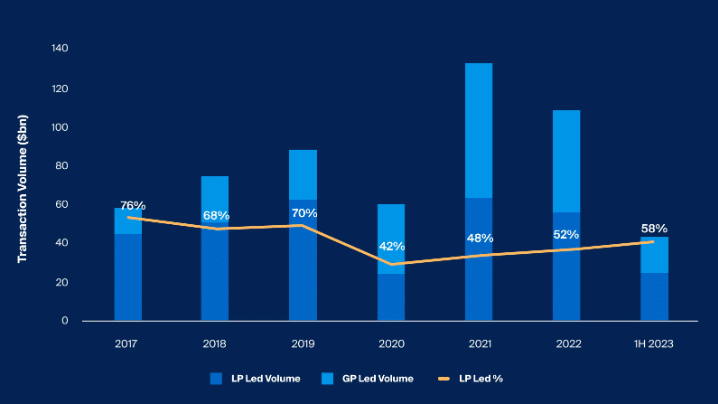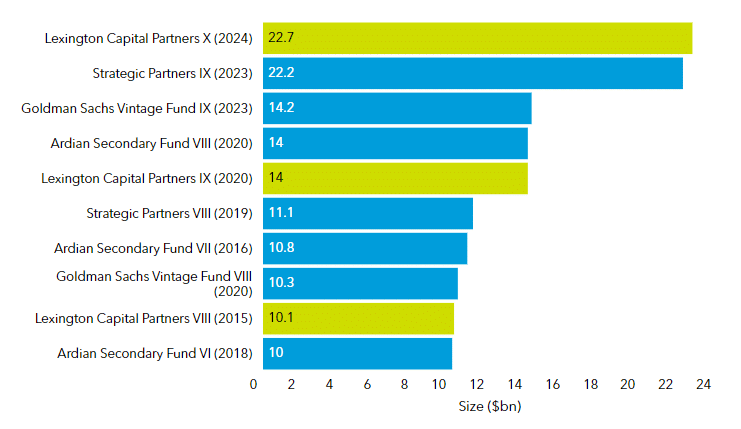VC Secondaries: Is The Market Ready?

VC secondaries, buying shares in VC-backed startups in the VC secondary market, has become a trending topic in Venture Capital as more industry players strive to get liquidity. Founders, GPs, and LPs are looking for solutions to sell their shares in single startups or entire portfolios. How real is the market opportunity? I talked to Alexandre Covello, Managing Partner at 109 Capital, who provides liquidity solutions to the VC ecosystem. His take: Despite the hype, the VC secondary market is not here yet.
In This Post
- VC Secondaries: What Are We Talking About?
- How long have you worked in the secondary market?
- How big are VC secondaries today?
- You talked to many top VC secondaries players. Is the market ready?
- Why has the current market reset not created more opportunities to acquire assets in the VC secondary market?
- What are the average discounts on VC Secondaries?
- You mentioned a lack of buyers among traditional secondary firms. How about other market players?
VC Secondaries: What Are We Talking About?
The term encompasses different realities, leading to some confusion. The VC secondary market covers three segments, each offering unique opportunities and challenges.
Direct Secondaries involve the sale of shares directly from existing shareholders, including Founders, early employees, or Investors, to new Investors. Direct secondaries provide a pathway for early stakeholders to realize gains from their investments outside of a liquidity event (typically an IPO or acquisition).
LP-led Secondaries involve the transfer of interests in VC funds from one limited partner (LP) to another, offering liquidity to Investors seeking to exit their positions before the fund’s dissolution. This market has grown substantially, driven by LPs’ need to rebalance portfolios, meet liquidity needs, or adjust exposure to Venture Capital as an asset class.
GP-led Secondaries include several types of transactions. Continuation funds are specially created vehicles that allow existing investments to be transferred from an older fund into a new fund structure. This enables general partners (GPs) to hold onto promising companies for extended periods while providing liquidity options to LPs. Other types of GP-led secondary transactions include tender offers, where GPs facilitate a process allowing existing investors to sell their shares to new investors at a predetermined price, and strip sales, where GPs sell a portion of their portfolio.
Each of these segments plays a vital role in the VC secondary market, offering different levers for liquidity and investment strategy optimization. While LP-led transactions constituted the bulk of the secondary market historically, GP-led transactions have rapidly evolved in recent years.
Secondary Transaction Volume (2017-1H 2023)

Given his longstanding experience in VC and PE since the early 2000s and his firm’s focus, I asked Alexandre about the reality of LP-led secondaries within Venture Capital.

Alexandre Covello has invested in PE and VC for 20 years across several firms, including LGT, HarbourVest, AngelsCube, and 109 Capital. He gathered a deep understanding of secondary market solutions, which he deployed through 109 Capital.
How long have you worked in the secondary market?
Alexandre Covello: “I spent 10 years as an investor with large funds, first with LGT Capital Partners in Zurich, where I stayed six years, with a strong focus on secondaries. Afterward, I moved to London to set up a secondary private capital advisory group, Arcanam Capital. After a short stint at HarbourVest, I left the PE secondary market behind in 2012 to focus on primary VC investing through AngelsCube and the HBS Alumni Angel, based in London.”
“I have been involved in private secondaries since the early days. I took part in one of the first European LP stakes transactions, acquiring an LP stake in a US private equity fund in 2022. Fast forward 10 years, I executed one of the first GP-led transactions in 2012. I founded 109 Capital in 2020 to take a position in the VC secondary market, poised to grow given liquidity needs. We are a specialist VC manager focused on acquiring mature portfolios of growth technology companies and advising both LPs and GPs with VC exposure on unlocking value from their portfolio allocation.”
How big are VC secondaries today?
Alexandre Covello: “The secondary market for the entire Private Equity asset class (which includes VC) is still relatively small. To put the numbers into perspective, the PE secondary market has reached about $100 billion in volume and is projected to reach $160 billion in the next few years. It’s quite small compared to the trillions of dollars invested in the asset class. So, in terms of volume, we’re talking about market segments that aren’t large. Yet, the PE secondary market grew from $20 billion a decade ago, so it’s a fast-growing segment. But it is still a very confidential market operated by specialized managers.”
I struggled to find data on the size of VC secondaries within the total PE secondary market. Industry Ventures estimated the total addressable market for VC secondaries at c.$140 billion globally in 2023, split 60% in direct secondaries and 40% in LP interests (IV does not report the GP-led segment separately). The actual transaction volume is challenging to estimate but is supposed to be much smaller to date.
You talked to many top VC secondaries players. Is the market ready?
Alexandre Covello: “There’s a lot of buzz around VC secondaries, but the market is still limited. The first problem is that there are few buy-side players. Today, there are no more than 40 to 60 professional buyers, with the top ten representing 80% of the market and raising mega-funds with billions of dollars in commitments. For instance, Lexington just raised a record $23 billion fund. HarbourVest, Ardian, Coller Capital, and a handful of others have also raised mega-funds in the $10-20 billion range.”
I found a ranking of the top 10 biggest standalone secondary funds, reproduced below. Strategic Partners is a Blackstone fund. What strikes me is that six of those funds were launched after 2020, reflecting the growing interest in PE secondaries.
Top 10 Biggest Standalone Secondaries Funds Ever Raised

Alexandre Covello: “The mega-fund managers focus on acquiring very large portfolios, the bulk of which are allocated to the buyout segment. Venture capital represents no more than 20% of portfolio allocations. The blended price of the overall portfolio often hides steep discounts applied to tech assets.
Why has the current market reset not created more opportunities to acquire assets in the VC secondary market?
Alexandre Covello: “The first reason is that potential sellers hold onto their assets. They’re not selling, and they’re waiting for things to get better. During the onset of COVID-19, I expected a pivotal shift. But in many countries, government-backed loans flooded the market, and a financial collapse was averted. Institutional investors, especially those with substantial holdings, opted for caution over hasty sales at high discounts, anticipating that asset values could rebound significantly within two to three years. They’re patient. They don’t want to appear foolish selling too fast, too cheaply.
Estimations for future growth in VC secondaries from the press and managers selling the opportunity to LPs are bullish. The VC secondary market is poised for growth now due to several key factors. LPs rebalance portfolios amid public and private market valuation gaps and seek liquidity due to underwhelming distributions from VC firms in this poor exit environment. GPs look for liquidity solutions in a challenging exit environment (sometimes asking LPs to recommit through stapled transactions) and raise continuation funds to give their trophy asset a chance to recover from unfavorable pricing.
Alexandre Covello: “Today, there are a lot of articles saying the VC secondary market is here. The reality is different. The buyers, the 60 large players I mentioned earlier, who represent 90% of dry powder in secondaries, focus on more predictable assets, such as LBO-backed companies. These traditional buyers tend to be less comfortable with VC portfolios containing unprofitable companies, are subject to the power law, don’t generate positive cash flow, and have limited exit predictability. There’s a problem on the buy side.”
“There’s also a problem on the sell side. Most VC GPs are not selling. Many family offices and corporate venture players want to exit Venture Capital, but they rarely hold promising assets. On the other hand, VC firms are okay with selling the average-performing assets but not their potential “fund returners,” the most promising startups in their portfolios—those moving the needle for their fund and generating their carry.”
Alexandre’s analysis touches upon core notions of how VC works. If you’re unfamiliar with them, here are some articles to dig further: the VC power law, where VCs focus their time, why “moving the needle” is a crucial investment criterion in VC, and how carry makes (some) VCs rich.
What are the average discounts on VC Secondaries?
Alexandre Covello: “Price is not the issue today; it’s the lack of buyers. You can get Mistral shares on the market for a 30% premium. The price for sexy AI assets that went on TV is through the roof. Good VC assets command a 40% to 60% discount on average. But these discounts don’t mean much, as assets were overvalued a couple of years ago, and many VC firms have not marked down their valuations. Even when they do, the basis for their new valuation is shaky, as there’s little financial information to base them on. The haircuts they apply are best guesses; they’re not based on hard data like in PE.”
Buying VC secondaries is like catching a falling knife.
Alexandre Covello – 109 Capital
Alexandre Covello: “You can find a lot of big names for sale today on the secondary market, such as SpaceX and Revolut. Information is accessible on these companies, so it’s easier to form an opinion on how to value them. However, smaller startups are much harder to evaluate. If the founder of a startup at the Series B or C stage doesn’t want to talk to you, you’ll struggle to value it. Even if you could form an opinion on valuation, there’s too little visibility on the timing of exits. You can’t run a DCF model like in PE because there’s too much variability. It’s much easier with PE assets, which have stable cash flows, visible exit scenarios, and make sensitivity analyses possible. That’s another reason why traditional secondary buyers pass on VC opportunities.”
You mentioned a lack of buyers among traditional secondary firms. How about other market players?
Alexandre Covello: “I pinned some hopes on family offices, which are traditionally more flexible when institutional investors are reluctant to innovate. So I called all the family offices I knew, only to realize they were more sellers than buyers. Private capital will probably not replace institutional buyers in the short run. In my opinion, the supply-demand imbalance will continue for a while.
“We need buyers attracted to VC risk-reward profiles and have risk appetite. Startup founders who made big exits and understand the asset class may be promising VC secondaries buyers. It’s important to spread the message about the opportunity in the portfolio acquisition segment.”
